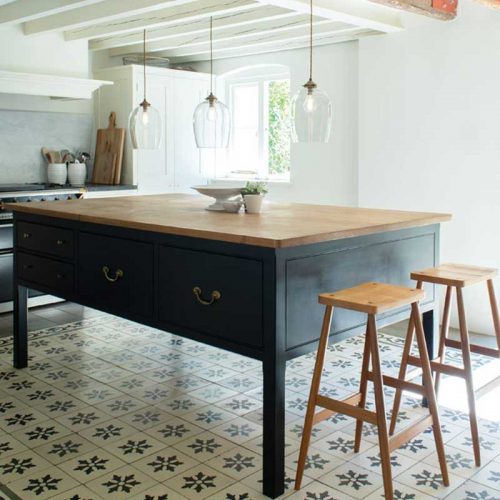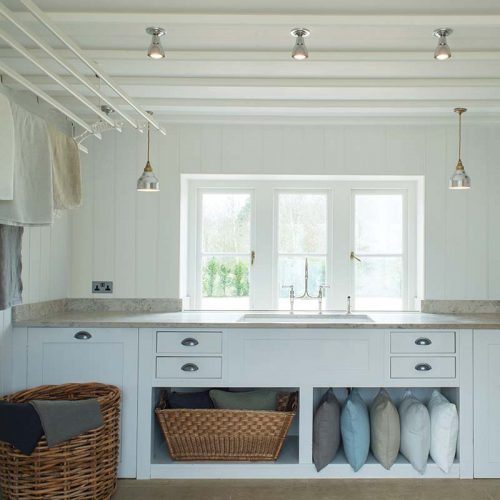This might seem like a big question…because it is! There are so many things to consider when choosing how to light your kitchen, so we’ve boiled it all down to a few key pointers.
A great kitchen lighting scheme has the power to transform an ordinary kitchen into a truly spectacular one. Now that we’re living in increasingly open plan spaces with kitchens at the heart of your home, they have to perform on a multifunctional level with lighting that needs to cater for tasking, dining, relaxing, office or homework and entertaining.
How much light you would like in a room is entirely up to you and your personal preference so there is no standard rule to follow. However, if you need a starting point then our guide below will give you some tips, things to consider and our general rules of thumb.
Brighter light is needed for tasking purposes whereas subdued light creates a sense of warmth and mood. Rooms that are multi functioning such as a kitchen, bathroom or utility room will require more light than a bedroom or living room.
Centrally placed pendant lights will throw their light all round a room equally so are better for general tasking purposes, whereas a wall or ceiling mounted spot light can be angled towards you to give bright, focussed light where needed, or away from you onto a wall or ceiling to add to the general ambience of the room.
As a rough guide, around 400 lumens would be suitable for a bed-sized table lamp, whereas you might want between 1,500 and 3,000 lumens in total (from more than one bulb) for a good-sized living room.
Let’s get a little technical. You can work out the level of light you need by calculating your room size in square metres and multiplying it by 19 for LED or CFL bulbs and by 15 for halogen bulbs. For example, if your room measures 4m x 5m it has an area of 20 square metres. If you are using LED bulbs, multiply this by 19 (20×19) giving a total of 380 watts, or a light level of 3800 lumens. The lumen level of each bulb will vary depending on the type of bulb and manufacturer so check the specific lumen level of each bulb to ensure you reach your overall target. For further information read our guide which features everything you will need to know about bulbs.
The rules that apply to kitchen lighting can be applied to every room in your home in that cleverly positioned lights can make a small room appear larger, disguise awkward architecture or compensate for poor natural light.
Look at your room and think about the activities that happen in each area. Some spaces, like food preparation zones, the sink and above the hob will require task lighting, as will a kitchen island. For variation in more open plan rooms or those with a dining area will require mood and accent lighting.
Task lighting refers to the places where you work the most so need the brightest lights, such as worktops, over the cooker and sink. There are lots of varieties to choose from, from compact fluorescent strips or LED under-cupboard downlighters that are slim enough to be recessed into the bottom of overhead units, to flexible LED strip lighting mounted on the underside of cupboards.
Even Pendants like our Weston Pendants can highlight task areas beautifully whilst adding some variation from directional spotlighting. Using dimmable bulbs with a dimmer switch is a fantastic way to achieve versatile lighting as you can choose to have bright light were needed and create soft, ambient light by decreasing power to the light source.
As well as creating a focal point in your room, ceiling lights like these Flush Edgeware lights are omnidirectional – casting their light equally everywhere – which is a must for tasking purposes. Alternatively, adjustable spotlights fitted directly above the hob, sink and chopping board will ensure bright, focused lighting.
![]()
If you have a kitchen diner or family room adjoined to your kitchen you will need to create a softer ambience to make everyone feel relaxed. Start by looking at how much natural light comes into the room and where it falls and where you need additional lighting.
It’s worth considering dimmable wall lights or spotlights that can be moved alongside more decorative systems, as these will give a subtle background illumination. For high ceilings, uplighters on top of the kitchen cabinets or spot lights hung along beams will enhance the general light. All of our pendants come with cable and chain that can be easily shortened at home, so you can enjoy any design you like no matter your ceiling height. These Leiston Pendants shown above are perfect for any modern country kitchen that needs a wide pool of light. We paint the inside of our large Leiston Pendant Lights ivory to beautifully reflect the bulb and add more of a gentle ambience to your room.
For island units or kitchen tables, consider a rise-and-fall fixture like our Butler above the table that can be pulled down for a cosy candlelit supper or raised for everyday meals and other activities. If possible, make sure your lights are controlled separately so you can create different moods at the flick of a switch.
The final layer of lighting that you will need to consider is how to create character and in your room. This is done using accent or feature lighting that guides the eye and creates points of interest around the room as well as adding to the overall light. Accent lighting could be subtle strip LED lighting on shelving, along the plinth of your kitchen island, in cupboards or in niches that highlights your room’s natural features It can also refer to the fitting itself, which makes a statement whether on or off.
A series of beautiful pendant lights like our Deben, Shotley and Bellingham shown above, or a fabulous single statement piece above a dining table will help differentiate the dining space from the kitchen’s work zones. Try hanging pendants low over the table for a feeling of intimacy or position them high over kitchen islands. This not only provides a great source of light, it also adds interest, breaking up the austere lines of cabinets.
Now all you have to do is choose beautiful designs that you love. Browse our Wall Light, Pendant Light and Spotlight pages on the website to find your match. For more information on lighting, bulbs and more FAQ’s head to our Knowledge Base. If you have any questions about fitting your lights, we are always happy to help, so give us a call or drop us an email and we will do our best to meet your needs. For even more home interior ideas, keep up to date by following us on Instagram, Twitter and Facebook. Don’t forget to tag us in your home updates– we love seeing our products in their new homes!









Leave a Comment